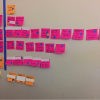 |
Top 10 AgileConnection Articles of 2017 Agile software development is mainstream by now, but people are still finding ways to experiment with agile. Measuring agile success with metrics, the debate over whether to use estimates, and improving predictability in Scrum were all hot topics last year. The rise of DevOps has given even more material for people curious to adopt the practice, so automation and "continuous everything" were also popular subjects.
|
|
 |
Experimenting with Daily Retrospectives Experimentation is a great way to unleash creativity, continuously improve, and see what works and what doesn't. When a team was tossing around the idea of doing daily retrospectives, agile coach Ben Kopel decided to guide them through some iterations on the process. Here, he talks about what the team did and what they gained from both the retrospectives and the quick feedback from experimenting.
|
|
 |
5 Overlooked Opportunities in Agile Estimation Agile story estimation gives the team insight into the level of effort for each work item, allows the team to assess each requirement’s relative priority, and lets the team refine and clarify story items. But there are even more benefits that can be gained from the estimation process. Try to take advantage of these five opportunities for growth when your team is estimating stories.
|
|
 |
The Ideal Workspace for an Agile Team If your agile team is all wearing noise-canceling headphones and stepping outside for conference calls, you have a problem. An agile workspace doesn't only mean putting everyone in the same room. The layout, configuration, and seating must be conducive to sustainable teamwork. Here are some tips about what an agile workspace is—and isn't.
|
|
 |
Fitting Technical Writing into Agile Development As teams strive to move to a mature agile process, technical writers must adapt as effectively as the development personnel. This new agile process demands that knowledge dealing with software or product releases is only sparingly documented up front, making the technical writer's job of gathering information much more dependent on talking with people over reading requirements.
|
|
 |
Using Sprints for Agile Coaching Discussing the work to be done as a group, building in short iterations, getting feedback, and looking for ways to improve are not just practices for development teams—it is an effective way to achieve any goal. Here, Ben Kopel details his experience of working with other agile coaches in a sprint to hire a new ScrumMaster.
|
|
 |
Using Agile to Lead Your Agile Transformation There's something ironic about starting an agile transformation by spending six months creating a detailed transformation plan. We have to move away from a prescriptive playbook and toward a more responsive transformation model. Why not use the agile transformation as your first opportunity to be agile?
|
|
 |
8 Keys to Transforming into a High-Performance Agile Team Following an agile process alone will not guarantee your teams will be high performers. Teams undergo various challenges while transforming into a highly productive team. This article looks at the areas where teams generally struggle in adopting agile principles and the typical root causes for those struggles, as well as eight behaviors that can help drive teams toward greater success.
|
|
 |
Prevent Disaster by Righting Cultural Dysfunction on Your Team The space shuttles Challenger and Columbia were two of NASA's biggest disasters. Investigations into these accidents discovered the engineering issues responsible, but management practices and cultural barriers also were found to be contributing factors. Does your organization have a healthy culture that lets you safely voice concerns? It could help you prevent tragedy.
|
|
 |
For Agile to Succeed, Put People First There’s a lot of buzz in the agile world today about becoming more technical, automating everything, and learning the next miracle tool. While it’s important to establish a process, and tools can help with many steps of the software development lifecycle, the human contribution to project delivery is still the most important. Here are some qualities agile teams should encourage.
|
|

